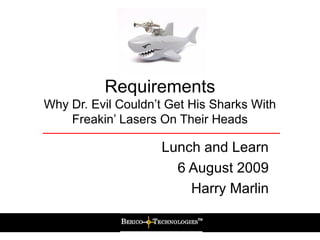Recommended
Oracle Support Services Customer Requirements for Support Services North Amer...

Oracle Support Services Customer Requirements for Support Services North Amer...Carlos F. Camargo, Ph.D. - Realtor, CalBRE #01988431
Recommended
Oracle Support Services Customer Requirements for Support Services North Amer...

Oracle Support Services Customer Requirements for Support Services North Amer...Carlos F. Camargo, Ph.D. - Realtor, CalBRE #01988431
More Related Content
Similar to Requirements
Similar to Requirements (20)
User research for Product Managers - Product Tank London Jan 17

User research for Product Managers - Product Tank London Jan 17
Customer Feedback: the missing piece of the Agile puzzle

Customer Feedback: the missing piece of the Agile puzzle
Hiring Right in a Tight Labor Market - Sheila Gladstone

Hiring Right in a Tight Labor Market - Sheila Gladstone
Hypothesis: “Pandemic lifestyle” remains and becomes permanent. Will your bus...

Hypothesis: “Pandemic lifestyle” remains and becomes permanent. Will your bus...
Finding the right authoring tool - STC Carolina Event 2018

Finding the right authoring tool - STC Carolina Event 2018
How to Build Winning Products by Microsoft Sr. Product Manager

How to Build Winning Products by Microsoft Sr. Product Manager
Requirements
- 1. Requirements Why Dr. Evil Couldn’t Get His Sharks With Freakin’ Lasers On Their Heads Lunch and Learn 6 August 2009 Harry Marlin
- 2. Why Requirements? A customer wants something You want to give it to them. How do you know what they want? Requirements!
- 3. What are Requirements? • Requirements are – A specification of what should be implemented – A description of how the system should behave – A constraint A “contract” between the user and the developer
- 4. Requirement Types • Functional – Functions the system should provide – System Behavior – Austin Powers shall die • Non-Functional – Speed, reliability, size – Fish shall skeletonize a person in 30 seconds – The death shall be slow and agonizing
- 5. What is a good requirement? • Complete • Unambiguous • Necessary • Describes one item • Feasible • Necessary • Testable/Verifiable Should define WHAT not HOW
- 6. The Customer/Stakeholder • An individual or organization who benefits from a product • May: • Pay for • Select • Specify • Use • Receive output Should “sign off” on requirements before development
- 7. Case Study
- 8. Case Study: The Customer Dr. Evil
- 9. Case Study: The Developer Number Two
- 10. Case Study: Developer #2 Scott Evil
- 11. Conclusion • Requirements give the customer what they really want • Good requirements are hard to make – but critical • Changing a requirement is easy, changing a system is hard Sometimes Sea Bass are better than Sharks!
Editor's Notes
- Our Customer intuitively understands what outcome he wants, but never really specifies his requirements. He expects his minions to give him exactly what he wants, and is peeved when he doesn’t get it.
- Number 2 is like many developers – the customer wants something, and we can’t provide it, so what is the next closest thing which would fulfill his wants. In this case, it worked out well – but that’s also because Number 2 had a long relationship with the customer beforehand, and understood what he wanted to accomplish.
- Our next developer thought a little deeper about what the customer actually wanted to accomplish, although he fell into the classic mistake of offering a solution, rather than defining the requirement. ---- The customer *really* didn’t like his idea, and you may have heard this last part at some of our own meetings with our customer
